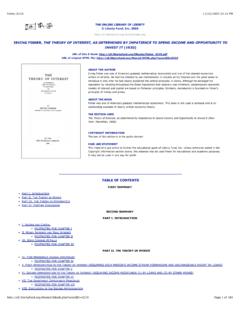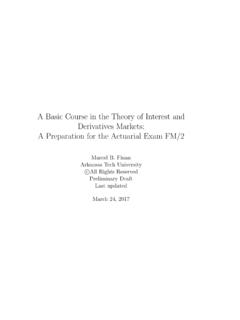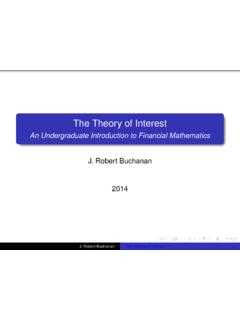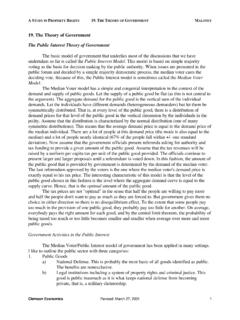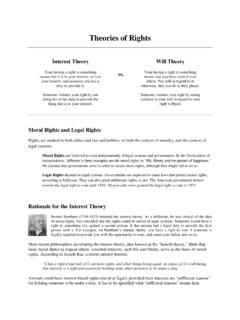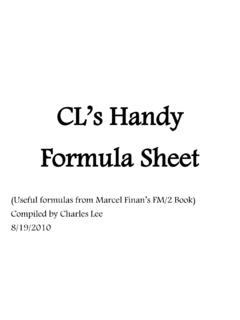Transcription of A Theory of Interest Rates - fh-luebeck.de
1 A Theory of Interest Rates Hendrik Hagedorn 10th October 2017 AbstractThe Theory contained in this essay builds on H ulsmann s Theory of Interest andthe capital Theory of Lachmann and Kirzner. The combination of these theoriesyields a praxeological Theory that explains the rate of Interest . In particular, itis shown that the Interest rate corresponds to the (properly defined) marginalproductivity of fixed capital, which contrasts with the pure time preference theoryof Interest . The results rather resemble those of B ohm-Bawerk. Preliminary work Contact the author under Introduction12 Character and scope of the theory43 The praxeological Theory of interest84 The praxeological Theory of Interest rates125 Discussion19A Mathematical formulation211 IntroductionThe Theory of Interest is, in a manner of speaking, the Mecca of economic self-esteemed economist has gone there, at least once in his lifetime; some ofthem whole-heartedly, others with the best intentions, and again others because theydeemed it appropriate to also embark on the subject.
2 Nonetheless, the question asto what determines the rate of Interest must be considered as hitherto , the situation today is not much different from that of the days of Eugen vonB ohm-Bawerk, who once wrote thatthe present position of the Theory (of Interest ) exhibits a motley collection ofthe most conflicting opinions, no one of them strong enough to conquer, andno one of them willing to admit defeat; the very number of them indicatingto the impartial mind what a mass of error they must example, the Interest Theory that is mostly endorsed by Austrian economists is theso called pure time-preference Theory of Interest , which asserts that Interest is theexclusive result of the time preference of human beings, their general preferring ofthings that are closer in time over things that are more distant in time ( Mises, [1949]2008, pp. 521). This Theory however clashes with many other stances.
3 Neoclassicaleconomists, for instance, see the rate of Interest as simultaneously determined by (andequal to) the marginal productivity of capital, the time preference of the representativeagent, and the income share of the capitalists, whereas in the Keynesian account interestis seen as the price of money, mainly determined by liquidity , even within the Austrian school we observe conflicting views. Some Austrian schol-ars like Murphy (2001, ) and H ulsmann (2002) challenge the pure time-preferencetheory altogether, stating that it is not even a praxeological Theory , and among thosedefending the Theory an incoherent picture emerges. While Kirzner ([1993] 2011, )asserts that the pure time-preference Theory addresses a question that is different fromthat of Interest rate determination, Rothbard ([1962] 2009, ) maintains that the in-terest rate is solely determined by time preference and greatest disagreement is presentwhen it comes to the effect of other factors on the rate of Interest .
4 Ingo Pellengahr,who devoted most of his research to reviewing this literature, describes the situationamong the adherents of the pure time-preference Theory as follows:1B ohm-Bawerk (1890, ).1 Whereas Fetter predicts that [a rise in physical productivity] will lower therate of Interest , Rothbard asserts that [it] will not affect the rate of interestat all. Kirzner does not exclude that it willaffectthe rate of Interest ,whereas Garrison (adducing to Fisher s reason, not Fetter s) contends thatitmightactually lower that B ohm s opening remark this calls for some elaboration. The goal of this essayis thus to solve the conundrum of Interest rate determination using the praxeologicalmethod, as will be presented in Section , before going there a few preliminaries will have to be undertaken. Section 2will present the methodological framework of this paper and Section 3 will discussthe praxeological Theory of Interest as such, without addressing the question of thesize of the rate of Interest yet.
5 Moreover, the remainder of this Section will clarifythe concepts and terms involved. For Interest Theory is replete with unclear and evenconflicting is therefore henceforth understood as the part of the spread between revenuesand costs that cannot be competed away by entrepreneurial effort, not even in Theory (cf. Mises [1949] 2008, ; Kirzner [1993] 2011, ; H ulsmann 2002, ).In other words: There is, in the entire economy, a systematic spread between the totalproceeds earned from the selling of products and the total expenditure paid for factorsof production. This spread occurs over time, it is measured between the momentof investing and the moment of selling, and it occurs repeatedly, which is why it issometimes considered as permanent. The part of this spread that can or could bedissolved in a process of competition is called entrepreneurial profit. The remainder iscalled alternative but equivalent way of describing the phenomenon is given by B ohm-Bawerk.
6 He introduces the concept of Interest as is the owner of a capital sum is ordinarily able to derive fromit a permanent net income.. This income .. arises independently ofany personal act of the capitalist. It accrues to him even though he hasnot moved a finger in creating it.. It can be derived from any capital,2 Pellengahr (1996, ), emphasis in the original. The sources that he refers to in this passageare Fetter (1915, ), Rothbard ([1962] 2009, ), Kirzner ([1993] 2011, ), and Garrison(1979, ).2no matter what be the kind of goods of which the capital consists, fromnaturally fruitful, as well as from barren goods, from perishable as wellas from durable goods, from money as well as from commodities. And,finally, it flows without ever exhausting the capital from which it arises,and therefore without any necessary limit to its continuance.
7 And sothe phenomenon of Interest presents, on the whole, the remarkable pictureof a lifeless thing, capital, producing an everlasting and inexhaustible flowof difference between the two formulations only lies in the chosen perspective. Theformer definition takes on a rather aggregate view while the latter looks at the problemfrom the standpoint of an individual. Yet, they are nonetheless equivalent since it isprecisely the spread between revenues and costs that cannot be competed away thatrepeatedly accrues to the capitalists without them becoming active. Moreover, in bothcases the various forms of Interest are only special cases of Interest income in see from these definitions that Interest Theory is at the same time a Theory of pricerelations between production factors and final goods and a Theory of distribution, whichis why Interest Theory is of central importance to economics in general. Historically,however, the focus has been on distribution and in particular on the question whetherinterest is a justifiable form of income.
8 In more theoretic terms this means whetherinterest is a natural phenomenon in the economy. If we assume that it was not, the capitalistic system worked to eradicate the entire spread between the revenuesof businesses and costs of factors of production, then any Interest income would implythat a loss of the same amount was incurred by another other words, positiveaggregate Interest would then either emerge at the expense of the wage earners or itwould entail a certain rate of bankruptcy in the economy. On the other hand, if weknew that aggregate Interest is generally greater than zero then - given the fact that thefree market economy is by definition a system of voluntary exchange - not all capitalistincome must be attributed to various forms of , a spread between revenue and costs is generally just some money that abusinessman makes. Whether this money is Interest or profit can empirically not bedistinguished.
9 The same is true when rent is obtained for the lending of a durable good3B ohm-Bawerk (1959a, )4 Provided the amount of money in circulation remains constant. In this paper we shall ignore theproblems of monetary expansion when Interest is received on a loan. In all these cases Interest is only a componentof gross profit of unknown magnitude. Hence, Interest and profit can in general onlybe separated on theoretical , one should note that, according to this definition, Interest is not a price andin particular not the price of capital. Interest , by any of the above definitions, is asum of money and the Interest rate is defined via the ratio of these two rate is thus a percentage without dimension. Prices, in contrast, are exchangeratios between two types of goods and therefore have a dimension. It follows also thatinterest Rates can only be defined in the context of a monetary economy because onlythen are the amount invested and the amount returned of the same physical nature sothat the rate of return can be Character and scope of the theoryIn order for a Theory to solve the question of Interest Rates indisputably and in anall-encompassing manner the Theory must meet two conditions, a necessary conditionand a sufficient one.
10 The first and necessary one is stability. Any Theory of interestmust show that there actually is room for Interest income to emerge, not at the indi-vidual level, but in the aggregate. Such a Theory is provided by George Reisman whodemonstrates that the capitalist system is inherently profitable and, thus, inherent profitability stems from the fact that there are pay-ments that firms generally make, which are not factor payments and which thus nevershow up as costs. Most notably, these are dividend payments and other forms of profitdistribution. Those payments, just like wages, flow back to the households and areeventually spent. The total amount of money spent on the products of businesses isthus generally higher than the total amount spent on factors of production, which issufficient to prove the ([1990] 1998, ) illustrates this result with a table that is reproduced inTable 1, where he makes the simplifying assumptions that wage earners spend theirentire income on consumer goods in each time period, they do not save and never5 See Equations (1) and (2) in the equivalent to those of Reisman were obtained by Kalecki (1935, ; [1952] 1969) andRobinson (1956, ,75,255).
